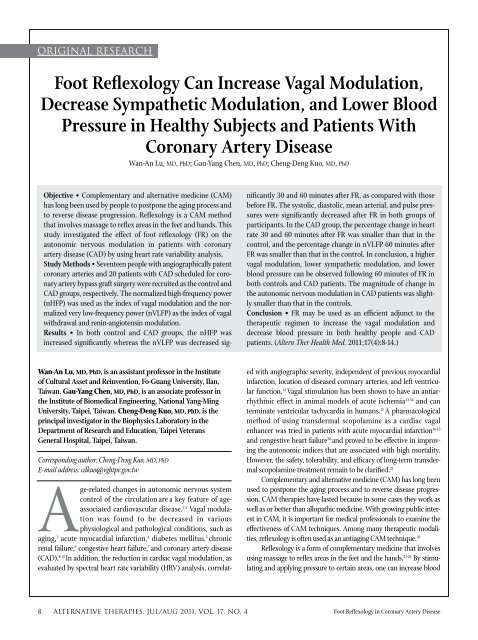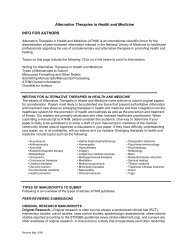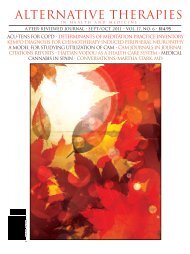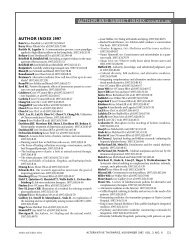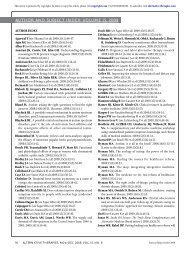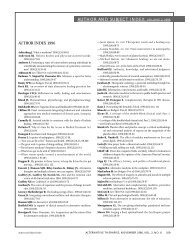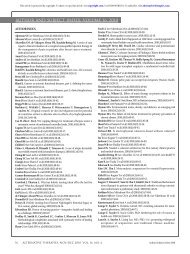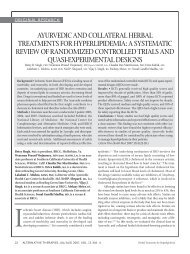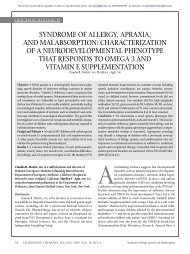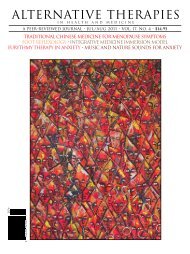Alternative Therapies In Health And Medicine
Alternative Therapies In Health And Medicine
Alternative Therapies In Health And Medicine
You also want an ePaper? Increase the reach of your titles
YUMPU automatically turns print PDFs into web optimized ePapers that Google loves.
ORIGINAL RESEARCH<br />
Foot Reflexology Can <strong>In</strong>crease Vagal Modulation,<br />
Decrease Sympathetic Modulation, and Lower Blood<br />
Pressure in <strong>Health</strong>y Subjects and Patients With<br />
Coronary Artery Disease<br />
Wan-An Lu, MD, PhD; Gau-Yang Chen, MD, PhD; Cheng-Deng Kuo, MD, PhD<br />
Objective • Complementary and alternative medicine (CAM)<br />
has long been used by people to postpone the aging process and<br />
to reverse disease progression. Reflexology is a CAM method<br />
that involves massage to reflex areas in the feet and hands. This<br />
study investigated the effect of foot reflexology (FR) on the<br />
autonomic nervous modulation in patients with coronary<br />
artery disease (CAD) by using heart rate variability analysis.<br />
Study Methods • Seventeen people with angiographically patent<br />
coronary arteries and 20 patients with CAD scheduled for coronary<br />
artery bypass graft surgery were recruited as the control and<br />
CAD groups, respectively. The normalized high-frequency power<br />
(nHFP) was used as the index of vagal modulation and the normalized<br />
very low-frequency power (nVLFP) as the index of vagal<br />
withdrawal and renin-angiotensin modulation.<br />
Results • <strong>In</strong> both control and CAD groups, the nHFP was<br />
increased significantly whereas the nVLFP was decreased significantly<br />
30 and 60 minutes after FR, as compared with those<br />
before FR. The systolic, diastolic, mean arterial, and pulse pressures<br />
were significantly decreased after FR in both groups of<br />
participants. <strong>In</strong> the CAD group, the percentage change in heart<br />
rate 30 and 60 minutes after FR was smaller than that in the<br />
control, and the percentage change in nVLFP 60 minutes after<br />
FR was smaller than that in the control. <strong>In</strong> conclusion, a higher<br />
vagal modulation, lower sympathetic modulation, and lower<br />
blood pressure can be observed following 60 minutes of FR in<br />
both controls and CAD patients. The magnitude of change in<br />
the autonomic nervous modulation in CAD patients was slightly<br />
smaller than that in the controls.<br />
Conclusion • FR may be used as an efficient adjunct to the<br />
therapeutic regimen to increase the vagal modulation and<br />
decrease blood pressure in both healthy people and CAD<br />
patients. (Altern Ther <strong>Health</strong> Med. 2011;17(4):8-14.)<br />
Wan-An Lu, MD, PhD, is an assistant professor in the <strong>In</strong>stitute<br />
of Cultural Asset and Reinvention, Fo-Guang University, Ilan,<br />
Taiwan. Gau-Yang Chen, MD, PhD, is an associate professor in<br />
the <strong>In</strong>stitute of Biomedical Engineering, National Yang-Ming<br />
University, Taipei, Taiwan. Cheng-Deng Kuo, MD, PhD, is the<br />
principal investigator in the Biophysics Laboratory in the<br />
Department of Research and Education, Taipei Veterans<br />
General Hospital, Taipei, Taiwan.<br />
Corresponding author: Cheng-Deng Kuo, MD, PhD<br />
E-mail address: cdkuo@vghtpe.gov.tw<br />
Age-related changes in autonomic nervous system<br />
control of the circulation are a key feature of ageassociated<br />
cardiovascular disease. 1,2 Vagal modulation<br />
was found to be decreased in various<br />
physiological and pathological conditions, such as<br />
aging, 3 acute myocardial infarction, 4 diabetes mellitus, 5 chronic<br />
renal failure, 6 congestive heart failure, 7 and coronary artery disease<br />
(CAD). 8-12 <strong>In</strong> addition, the reduction in cardiac vagal modulation, as<br />
evaluated by spectral heart rate variability (HRV) analysis, correlated<br />
with angiographic severity, independent of previous myocardial<br />
infarction, location of diseased coronary arteries, and left ventricular<br />
function. 12 Vagal stimulation has been shown to have an antiarrhythmic<br />
effect in animal models of acute ischemia 13,14 and can<br />
terminate ventricular tachycardia in humans. 15 A pharmacological<br />
method of using transdermal scopolamine as a cardiac vagal<br />
enhancer was tried in patients with acute myocardial infarction 16-19<br />
and congestive heart failure 20 and proved to be effective in improving<br />
the autonomic indices that are associated with high mortality.<br />
However, the safety, tolerability, and efficacy of long-term transdermal<br />
scopolamine treatment remain to be clarified. 21<br />
Complementary and alternative medicine (CAM) has long been<br />
used to postpone the aging process and to reverse disease progression.<br />
CAM therapies have lasted because in some cases they work as<br />
well as or better than allopathic medicine. With growing public interest<br />
in CAM, it is important for medical professionals to examine the<br />
effectiveness of CAM techniques. Among many therapeutic modalities,<br />
reflexology is often used as an antiaging CAM technique. 22<br />
Reflexology is a form of complementary medicine that involves<br />
using massage to reflex areas in the feet and the hands. 23-26 By stimulating<br />
and applying pressure to certain areas, one can increase blood<br />
8 ALTERNATIVE THERAPIES, jul/aug 2011, VOL. 17, NO. 4 Foot Reflexology in Coronary Artery Disease


